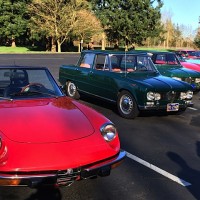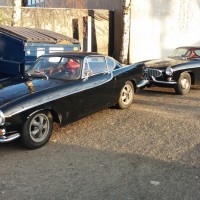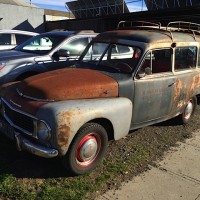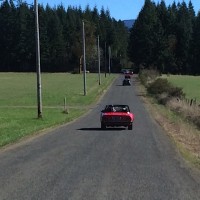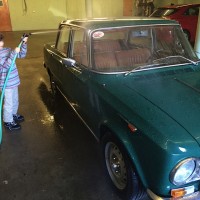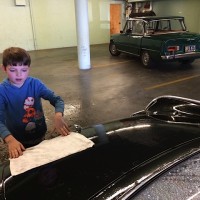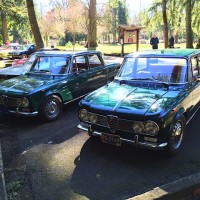
A Gearhead’s Trip Through A Vintage-Car Theme Park
You can tell the weather is getting better because I’m spending more time in the SCM/ACC garage.
It all started last week when seven-year-old Bradley asked if I would take him to school in the Viper. I asked why that car, and he replied that he had never been in it. Which seemed like reason enough.
The Viper has an airbag-disable switch on the dash, so taking a child in it doesn’t present a problem.
I hadn’t driven our 2000 GTS ACR Viper coupe in awhile, and I was pleasantly surprised to be reminded of what a raw, visceral machine it is. Compared with the float-like-a-butterfly-sting-like-a-bee performance of the 2001 911 Turbo, the Viper is like a cage-fighter, muscles bulging from every wheelwell.
You don’t “take a line” through a curve with the Viper – you dare the road to slow you down. With a total lack of electronic “driver diapers” (systems that make you look like a better driver than you are and keep you from going into the weeds), the Viper rewards aggression and punishes stupidity.
We fired up the Viper, and it roared through the Borla exhaust. Bradley said, “Daddy, it growls like a bear.”
The ACC gang has put over 5,000 miles on the car in the year we have had it – it only had 1,700 when we bought it. The GTS is one of the last great, basic muscle cars, and driving it is like a trip back through time.
My Méhari
The SCM Méhari had been sitting in the garage while I tried to figure out what the glowing yellow light on the dash signified. When I posted a picture on Facebook, several responses indicated that it was the oil pressure light. That would not be good news, as driving it with low oil pressure might have damaged the crank. I have learned that replacement cranks are essentially unobtainium; it’s easier to replace the entire engine.
Citroën enthusiast Paul Duchene put me in touch with the local guru, Bill Lonseth. Using the magic of iPhone photography and instant messaging, we determined that someone had cross-wired the charging light and the oil pressure light on the dash.
I have now added to my body of useless car knowledge the location of the oil-pressure sending unit on the 602-cc engine. I’ve also learned it’s easy to cut your hand reaching for it.
I got the Méhari running and gave Bradley a ride around the block. He wanted to know why I bought a golf cart.
Alfa Time
Saturday was the Alfa Romeo Owners of Oregon‘s Valentine Day tour (a week late, but after all this is an Italian-car club). I decided to take the Super for its first test drive since Dan Sommers of Veloce Motors rebuilt the 2-liter engine.
The 1967 Super is a very solid car. It came to me with a 1,750-cc engine, and when Sommers found problems with it, he recommended upgrading to a 2-liter in a mild state of tune. As the original 1,600-cc engine was long gone, I had no hesitations about the swap.
The suspension of the Super is in fine fettle. The car is lowered and has competition springs, Bilsteins and front and rear sway bars. It rides on 185/65 tires on 14-inch wheels. The 4.1 limited-slip rear axle makes freeway cruising pleasant. The previous owner, Dr. Tim Rodgers of Santa Barbara, put a lot of time and money into the car, and it is apparent.
The Super is not a show car, but a complete and correct daily driver – my preferred condition.
It is a four-door family car, so I invited SCM’s SEO consultant and fellow gearhead, Michael Cottam, and his 8-year-old son, Benjamin, to join Bradley and me. When we told the boys they would be our official navigators, they became completely engaged. They watched for street signs and turns, and both agreed that the tripmeter in the Super was useless for following rally instructions.
People often fret about how to get the next generation involved in old cars. I maintain you don’t “try to get them involved” — you simply involve them. Ben and Bradley didn’t really know that they were in a 48-year-old classic Alfa Romeo. They just knew they were part of a day’s adventure, and they were playing an important part.
There were over 20 cars on the tour — mostly 105-series Alfas from the mid-’60s and early ’70s, with a couple of earlier 750- and 101-series Spiders. My good friend Doug Hartman brought his immaculately restored 1967 Super.
AROO President Roger Dilts gave the instructions, and off we went. Leaving from the French Prairie rest area at milepost 282 on Oregon’s I-5, the tour covered about 75 miles, all scenic two-lane roads. We stopped midway at Feyrer Park, then finished at the Stone Cliff Inn in Oregon City.
Driving the Super with its 2-liter engine was very satisfying. With my five Alfas, the powerplants range from the edgy 1,400-cc engine in the ’58 Sprint, to the 1,600-cc Veloce engines in the ’65 Giulia Spider Veloce and the ’67 Duetto, to the upgraded 1,750-cc engine in the ’67 GTV, to the “big block” in the Super.
The added torque of the 2-liter is a perfect match for the Super. It pulls easily and quickly. It’s comfortable at 75 mph — critical in an old car today when you have freeway transits between two-lane road sections. The power, coupled with the buttoned-down suspension, made the car a delight to drive. We had no trouble keeping up with the Spiders and GTVs.
Plus, the two boys in the back seat were busy watching for signs and calling out directions, and they never once asked to play on the iPad. In my book, that’s a successful event.
(Click here to view my Facebook photo gallery with more pictures from the Alfa tour. You do not have to be a Facebook member.)
Black Beauty
Bradley and I got back to the SCM garage at about 1:30 p.m., just in time to meet Cameron Lovre, a vintage Volvo expert and friend. The 1964 1800S had developed a stumble upon hard acceleration, and Lovre thought he knew exactly what it was.
Within a few minutes, he had the air cleaners off, pushed up the pistons of the dual SUs and added oil to the dampers. Problem solved.
The monthly meeting of the Round-Fender Volvo Club was taking place just a few blocks away, so we drove over in the 1800S.
The RFVC is more loosely organized than the Alfa club, with an active membership of 30 or so. Its founder and benevolent dictator is Dean Koehler, who drove with me on a rally in Argentina recently.
There were a half-dozen vintage Volvos in the parking lot of the Lucky Labrador pub on SE Hawthorne Street.
Surprisingly, there was another black (paint code 19) 1964, owned by Colin Roberts. We parked the cars side-by-side and noted the differences between them. With cars this old, it’s a sleuthing game to figure out how they were originally built, and how they have been modified by owners over the years.
Soon enough it was time to leave. I thought back through the past week’s activities and reflected on how lucky I am to have so many friends who share a passion for old cars.
Jim Pickering, Editor of ACC and Managing Editor of SCM, chose the Viper, and it’s a good one. Duchene and Lonseth came to my rescue with the Méhari. Cottam and his son were perfect riding companions on the Alfa tour. And Lovre helped me get the 1800S in order for its debut with the Round-Fender gang.
I have long maintained that old cars are really just a magnet to draw like-minded people together. This past week was certainly a demonstration of that. Passionate enthusiasts celebrated the capabilities and quirks of four classic cars from four different countries.
